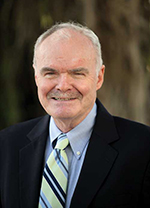
Before we archive this season of St. Patrick, let us reflect upon an aspect of the Irish impact on the United States—one that is obvious, yet little commented upon. And that is how Irish names have become so common as first names that people don’t give a thought about it. First, a little history.
One of the gifts from the English to the Irish was the English language and the abandonment of the awkward, often unpronounceable old Gaelic versions of names now common in English. Gallagher, for instance, was originally O’Gallchobhairk, Kennedy was O’Cinneide and Murphy was O’Murchada.
The Irish had streamlined those names in the century before arriving in the U.S. in large numbers in the mid-1800s, driven from home by famine and a life of near slavery under British rule. Note that a mere 75 years before, Irish names were all but absent on the Declaration of Independence. There was a Lynch from South Carolina but only Charles Carroll, a planter from Maryland, is remembered. A rare Irish Catholic, he was even rarer as one the wealthiest men in the colonies.
Irish immigrants for the most part proudly clung to their names—even if some of them could barely spell them—often at a cost. “No Irish Need Apply” signs were notorious. That prejudice gradually evaporated, so much so that today those Irish last names have enjoyed unique popularity—as first names. Today, of the ten most common Irish surnames, six of them have come to enjoy some use as first names. Murphy, Kelly, Brian, Ryan, Connor and Neil all began as last names or variations of some.
Go down the list of Irish last names and those used at least occasionally as first names jump out by the dozens. Riley, Emmett, Smith, Doyle, Murray, Quinn, Carroll, Grady, Brady, Connel, Burke, Nolan, Regan, Donovan, Barry, Ward, Graham, Cullen, King, Scott. In truth, not all are exclusively Irish; a number are shared by the rest of the British Isles, notably Scotland, whose genetics are virtually identical to Ireland.
This phenomenon, which has attracted its own websites, is a fairly recent development. The very popular name Ryan was little used until the 1970s when actor Ryan O’Neal brought attention to it. Some that have gained recent currency are literally reborn. Cormac (the Gaelic equivalent of Charles) traces to a fifth-century king named Cormac. Many Irish took that name during a time when people had only one name, but when the English imposed second names on their subjects, Cormac became McCormick. Now it has gone the other way. The distinguished author Cormac McCarthy, who changed his name from Charles, has led the charge.
Although the internet covers this subject in some detail, nowhere can we find an explanation for why the popularity of Irish names. Therefore let us conjecture. We think people take Irish names for children because they don’t know it. They are simply looking for acceptable American-sounding names. They want to fit in. And Irish names tend to be short—at least compared to other European backgrounds. This is not a trend likely to spread to other ethnic strains. We are not likely to see a lot of people with first names such as Putin, DiMaggio or Brzezinski.
Any way you slice it, it is what it is, just another feather in the crowded bonnet of a nationality who came to this country in poverty and hunger, anxious to blend with the established Anglo culture, and wound up being the blender itself.
Photo via

The latest thing in running for office in Florida is to not tell the voters what you stand for. It may be the best way to win an election. As an example, we give you recently elected Florida Gov. Ron DeSantis. If you followed the governor’s successful campaign last fall, you would have only a vague idea of what he would do if elected. He seemed to be a strong supporter of President Trump, wall and all, and had nothing negative to say about outgoing Gov. Rick Scott. A rational person would, therefore, assume that he did not believe in climate change, and saw nothing wrong with his predecessor’s steps, which did little to address the problems of Lake Okeechobee pollution and the effects on the estuaries on both coasts—especially in Martin County, as well as the ongoing neglect of the Everglades.
If you thought that, you were happily wrong. The Republican governor’s first months in office find him acting much like a Democrat—at least on those issues most important to those worried about Florida’s deteriorating environment. He has shown a determination to do something about the problems of Lake Okeechobee and South Florida’s threatened water supply. To say that environmental groups, most of whom opposed his election, are surprised, is to put it mildly.
Eric Eikenberg, chief executive of the Everglades Foundation, one of the most influential environmental groups, echoes the common theme: “This is the most optimistic we have been in decades —to have a governor who made cleaning up Everglades his No. 1 priority. We could not ask for anything more. Now we have to make sure that the legislature puts money behind those priorities and we can solve this problem.”
It was not just the new governor’s actions, but the speed of them, that has generated enthusiasm from environmentalists. DeSantis lost no time in asking for the resignations of the entire South Florida Water Management District board of directors. These are the people who make the decisions that affect the water flow from Lake Okeechobee. While theoretically independent, the members are appointed by the governor and therefore reflect his views. And former Gov. Rick Scott’s views were a reversal from those before him.
Under Gov. Charlie Crist there was a plan to buy a huge parcel of land from U.S. Sugar Corporation, the Clewiston-based company that for decades has been growing sugar on land directly south of Lake Okeechobee. That land was once the headwaters of the “River of Grass” and constituted the northern reaches of the Everglades. Back in the day of Gov. Napoleon Bonaparte Broward (1905 to 1909), the land was drained with a network of canals to make it rich soil for agricultural
purposes.
Because South Florida was lightly populated at the time, turning wetlands into productive farmland had limited effect of the Everglades. But as our area became the most populous part of the state and the demand for water grew steadily, so did the damaging effects of the stunted water supply.
The problem was compounded by the loss of wetlands, which were a natural cleansing agent for fertilizer polluted runoff from all the farms. South Florida found itself in a strange situation. Lake Okeechobee was surrounded by a dike after disastrous flooding in 1928. Water built up in the lake during the rainy summers, but when the lake became dangerously high, water that nature intended to flow south into the Everglades was discharged through canals east and west. Areas that did not need water, such as the Stuart area, got too much polluted water, while the Everglades to the south did not get enough.
The U.S. Sugar land acquisition plan would enhance the natural flow of water, in effect restoring a crucial part of The Everglades. But under Gov. Scott, the plan to purchase land died. A spokesman for U.S. Sugar said it decided not to sell after the state changed its mind about buying the land. But the truth is Gov. Scott nixed the deal by appointing his own people to the Water Management District.
In recent years, the situation became disastrous, at least for Martin County, as polluted water from the lake merged with seawater, producing an algae buildup, which killed sea life in an area where the economy depends on its reputation as a water wonderland. Gov. Scott’s administration worsened the problem by replacing management of the South Florida Water Management District with directors who favored the polluting agricultural interests over environmental concerns. Scott was obsessed with growth and new jobs. He showed little interest in people already living here. Eight years were wasted, and those years finally saw decades of neglect have their effect. In addition to pollution on both coasts opposite the lake, rising sea levels have been creeping inland, under our shallow crust of soil, encroaching on freshwater supplies for millions of people in Palm Beach, Broward and Dade counties.
Now all this history has been widely publicized. It is hard to live in South Florida without understanding at least the basics of the water problem. But one might think Gov. DeSantis, from far up in Daytona Beach, would not be acutely aware of the situation.
Wrong. So far.
Photo via
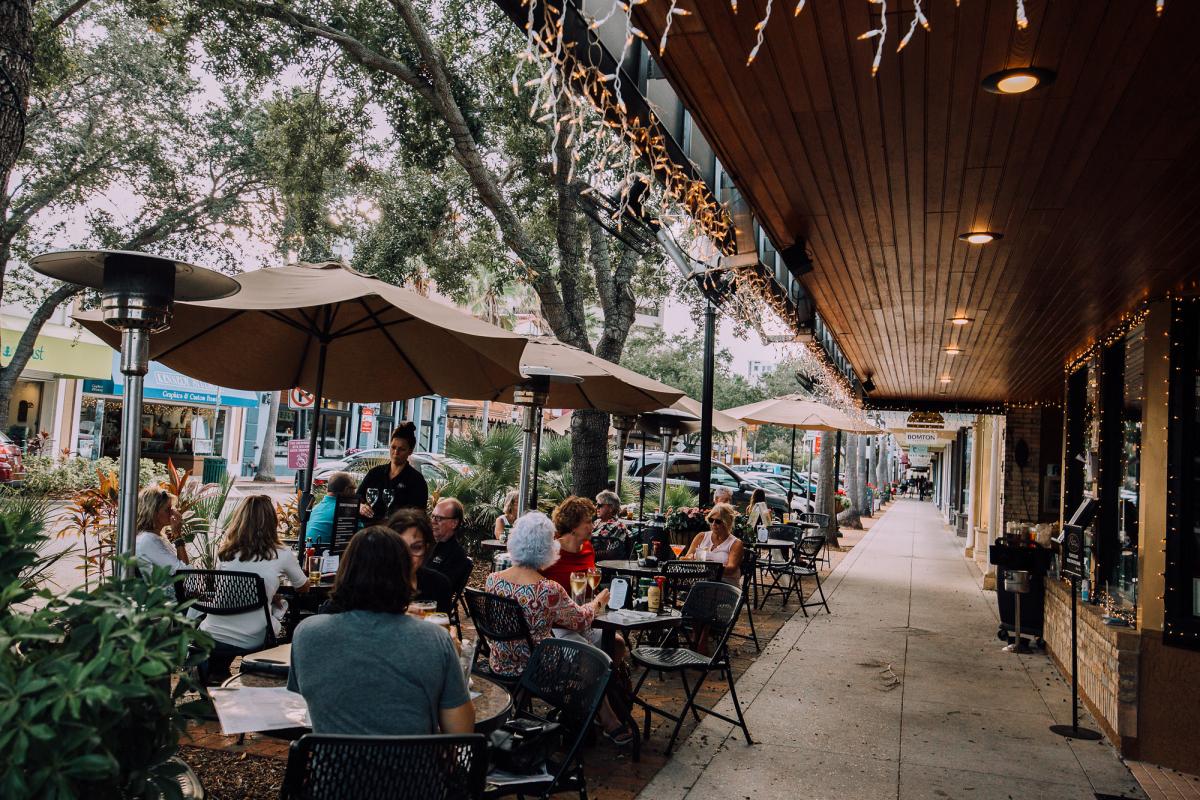
The college traced its roots to 1809 when it began as a small Catholic boarding school for middle-class girls in a remote and peaceful part of Maryland. A Washington newspaper once described it as “the kind of setting Hollywood used to seek out for inspirational movies.” The nearest town was Emmitsburg, and it lay in a valley bordering the Catoctin Mountain range. Except for a dramatic few weeks 50 years later, it has remained remote and peaceful. The summer of 1863 was the exception; when the great Civil War battle of Gettysburg took place just 10 miles to the north, barely inside the Pennsylvania border. Union troops camped on the school grounds en route to the fight, and some Confederate detachments also passed near the campus. The nuns who ran the college cared for both Union and Confederate wounded after the bloody three-day battle.
One hundred and fifty-six years later the school is still there, at least the bucolic grounds, with stately red brick buildings. But it is no longer a college. Saint Joseph’s College closed in 1973 and the grounds are now the National Emergency Training Center. Saint Joseph’s, just down the road from the still going Mount Saint Mary’s, was a victim of its small size (about 600 girls at its peak), the growing unpopularity of one-sex colleges and the declining numbers of free teachers, i.e. the Daughters of Charity (the ones with the sailboat hats).
The college may be gone, but many of the women who attended it are still around. Considering how many of them hated the strict rules (in the late ’50s, girls were expelled for simply attending parties where alcohol was served), the loyalty of the alumnae is extraordinary. The campus reunions are fewer, but they have been so well attended over the decades that they used to say if a classmate did not show up, she had likely gone above.
And thus we traveled last month across the state to Sarasota, where the Saint Joseph’s class of 1961 has been holding informal reunions for close to 10 years. Sarasota is the site because several of the women are retired there, or have winter homes in nearby Gulf Coast cities. Others plan Florida vacations around the event. Although the numbers have declined as some women, and especially the husbands, have died. They still manage to draw a dozen women and assorted relatives and friends.
For those of us still moving, it is an opportunity to check out one of the state’s most distinctive communities, long noted as an arts center, and recently facing the usual problems of growth, i.e. redevelopment vs. overbuilding—resulting in a vibrant downtown compromised by too many people trying to move around in a small area.
Let’s start with the traffic—the root of the problem is what makes Sarasota such a beautiful spot. The large and magnificent bay provides wonderful sites for single homes and high-rise residences. But unlike the east coast, where most communities have access to the Atlantic beaches every few miles, the Gulf of Mexico beaches are reachable by a few causeways that are miles apart. The results are traffic jams both morning and afternoon. We are talking about serious holdups, lines of crawling vehicles sometimes a mile long. And the roads leading to those bottlenecks are equally congested. Aside from I-75, which lies farther out of town than I-95 does from east coast communities, the main road up and down the coast is U.S. 41. Compared to U.S. 1 on our side, it is frustratingly slow. A friend who met us for lunch in downtown checked his route guidance from his home and expected an 18-minute drive. But it took a full half hour due to traffic on U.S. 41.
Sarasota’s downtown is a bustling and attractive place, filled with restaurants and shops. The main shopping street, oddly enough, is called Main Street, and the shoppers and diners, reflecting the heavy retirement community, are conspicuously older than people on Fort Lauderdale’s Las Olas Boulevard. The retail presence is also obviously stronger and more varied with an emphasis on artsy stores. The downtown directory lists a dozen galleries, and not all are on the main drag. The commercial district extends to cross streets, which feature antique stores and a number of thrift stores. The latter is especially appealing to the Saint Joseph’s alumnae who reserve at least a day for touring those outlets.
The number of galleries and art-related stores reflects Sarasota’s long history as an art center. The Ringling, the State Museum of Florida, goes back nearly a century, to when the circus family first brought its love of art and antiques to the city. The Ringling College of Art and Design opened in 1931 and has a national reputation. All this is valued by its residents, both full time and winter, but they all deplore the building boom that has seen too many skyscrapers, too fast, too tall, too close together.
Sound familiar?
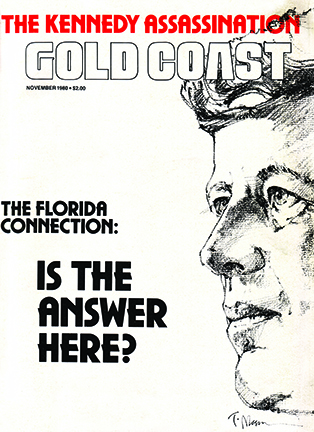
Judging by the media tributes that accompanied the death of President George H.W. Bush in December, we buried a near saint. Perhaps he was, compared to some of the figures who succeeded him in the Oval Office, but there was also a side to the senior Bush that received almost no mention in his many obituaries.
An exception was Tim Weiner, writing in The Washington Post, who hinted at what some researchers have long suspected—that Bush’s connections to the American intelligence community went far beyond his brief term as CIA director in the 1970s. Wrote Weiner: “He was the only president who ever ran the agency and the last president who truly believed in its Cold War code: Admit nothing, deny everything.”
That seemed like an odd comment, for the senior Bush served as CIA director for just a year. That is a puzzling short time to develop such an intense commitment to the agency. That is, unless Weiner, a Pulitzer Prize winner and authority on the FBI and intelligence operations, knew that the ex-president may have been a CIA asset long before he took the top job. President Bush appears to have been connected to our intelligence apparatus at crucial and controversial times in its history. There was even a book written about his clandestine past. It contradicts the portrait of Bush as an example of a kinder, gentler political era.
It goes back to 1953 before Bush became politically active. He formed Zapata Oil with a partner who had recently resigned from the CIA. Oddly enough, that partner later returned to the CIA during the period of anti-Castro activity in the 1960s. Researchers have discovered documents indicating a subsidiary of Zapata Oil used offshore drilling facilities in the Caribbean as a listening post to monitor Cuban activities. Zapata Oil may have been a legitimate oil exploration company, but it also appears to have been a CIA front. More than a few companies active in Latin America were.
Here’s where it gets interesting. Declassified government files led to the discovery in July 1988 that on Nov. 23, 1963—the day after President Kennedy was assassinated—“George Bush of the CIA” was given an oral briefing by the FBI. Now, what was that all about? When asked at the time, Bush first joked it off. Then the CIA suggested it was a different George Bush. There was another George Bush in the CIA at the time, but he was a low-level analyst and signed an affidavit saying there was no way he ever had an FBI briefing. President Bush’s office said it would not dignify the report with further comment, and to the best of our knowledge never made one these last 30 years. Admit nothing. Deny everything.
This snippet of history interests us because of Gold Coast magazine’s long interest in the Kennedy assassination, and the fact that our former partner, Gaeton Fonzi, has gone down in history as the author of one of the most important books on the subject. It was a book that began as two long articles in our magazine in 1979. “The Last Investigation” was the result of three frustrating years Fonzi spent as a Florida-based investigator for two government committees that reopened the investigation into Kennedy’s murder in the mid-1970s.
Fonzi was initially hired by Pennsylvania Sen. Richard Schweiker, who recalled articles Fonzi had written in the 1960s for Philadelphia Magazine. One of them was an interview with Arlen Specter, the man who came up with the “magic” bullet theory to show how a lone gunman could have killed the president. Specter astounded Fonzi by stumbling in trying to explain his own theory. By 1975, Schweiker, having studied Lee Harvey Oswald’s strange defection to Russia and mysterious return, was convinced that the accused assassin had “the fingerprints of intelligence all over him.” He also thought a close look at anti-Castro figures operating in South Florida could be productive.
It sure was. Fonzi discovered that a prominent Cuban anti-Castro leader in Miami had seen his main CIA contact in the company of Oswald in Dallas just months before the assassination. It reinforced what others, including Sen. Schweiker, had suspected—that rather than being “a lone nut,” Oswald was a CIA operative who had been set up. A “useful idiot” to use a favorite CIA phrase. By then Fonzi was working for a second congressional committee, the House Select Committee on Assassinations.
He was excited in 1976 when Richard Sprague, a brilliant prosecutor who Fonzi knew well from Philadelphia, was hired by Schweiker to head the committee. Fonzi thought if anybody could solve this crime, it was Sprague. Fonzi was anxious to follow up on his Oswald CIA connection. But Sprague’s time in Washington was short. Sprague was literally forced out of his job after some indiscretions in his past were publicized way out of proportion. It turned out Schweiker’s enthusiasm for solving the Kennedy assassination was not shared by other government officials. When congressmen on the committee, who now appear to have been CIA friendly, threatened to shut down the whole investigation because of Sprague, he resigned.
He later said his problems in Washington began when he refused to sign an oath of secrecy requested by the CIA. “My problems in Washington began when I knocked on the door marked CIA,” Sprague said. His replacement was G. Robert Blakey, a well-intentioned man with impressive credentials (Notre Dame law professor) but one who did not believe the CIA would lie to him or his committee. He preferred to concentrate on organized crime figures as possible assassins, and there were some mob connections to be explored. He later regretted his naiveté. The bottom line was that the HSCA investigation, rather than being thorough and conclusive, was rushed under budget pressures and vague in its final report. It said there was evidence of a conspiracy, but gave you multiple-choice options.
Fonzi, who had constant frustration trying to work with shadowy CIA figures in South Florida, was depressed. His magazine articles were in effect a dissenting opinion. We might add that we saw all this up close; Fonzi sometimes worked out of the Gold Coast magazine office (he was still contributing occasionally to the magazine) and sometimes used our phones. We never billed the government.
What does all this have to do with the late President Bush? Timing. Bush became CIA director in January 1976. Richard Sprague was hired to run the JFK investigation in October 1976. Although Sprague did not resign until March 1977, his problems with the CIA began soon after he was hired, and came to a head in early January 1977 when Bush was still CIA director. The obvious question: what did President Bush know about the CIA’s pressure to oust Sprague? As CIA boss, he certainly should have known something. And did he have anything to do with a decision, which turned out to have wrecked the last serious attempt to solve the murder of a president?
When Fonzi wrote his magazine articles in 1979, the strange FBI memo naming George Bush in connection with the Kennedy assassination briefing was not known. Fonzi did not make any reference to the above timing, but when his articles became a book in 1993, he included the mysterious memo. He did not, however, link Sprague’s downfall to the timing of Bush being CIA director.
By then Bush was president, and questions about the Kennedy assassination had greatly intensified. Jim Garrison’s book that inspired Oliver Stone’s 1991 movie “JFK” had been published. We asked Fonzi at the time why Bush would have denied the 1963 FBI memo, even going to the extent of the CIA saying it was a different man with the same name. Fonzi replied that in 1988 Bush was running for president, and any suggestion of a relationship to the Kennedy assassination, no matter how remote, could have been devastating to his election chances.
Fonzi died in 2012. If he were alive today, we think he would reflect on the Richard Sprague episode in 1977 with great interest. What, if anything, President Bush’s role was in that event may never be known. He took that information with him.
Admit nothing, deny everything. To death do us part.
***
As this article was being prepared, there came an announcement that members of the Kennedy and Martin Luther King families were among those who signed a petition asking Congress to reopen the investigations of the murders of President Kennedy, his brother Robert, Martin Luther King Jr. and Malcolm X. The list of those signing the petition is a veritable who’s who of prominent figures (those still alive) that have long challenged the official government versions of the JFK assassination. Notable among them: G. Robert Blakey, now in his 80s, is the same man who thought he could trust the CIA when he took over as head of the House Select Committee on Assassinations in 1977, and whose committee issued a report saying JFK’s death was a conspiracy but left us guessing by whom. Stay tuned.
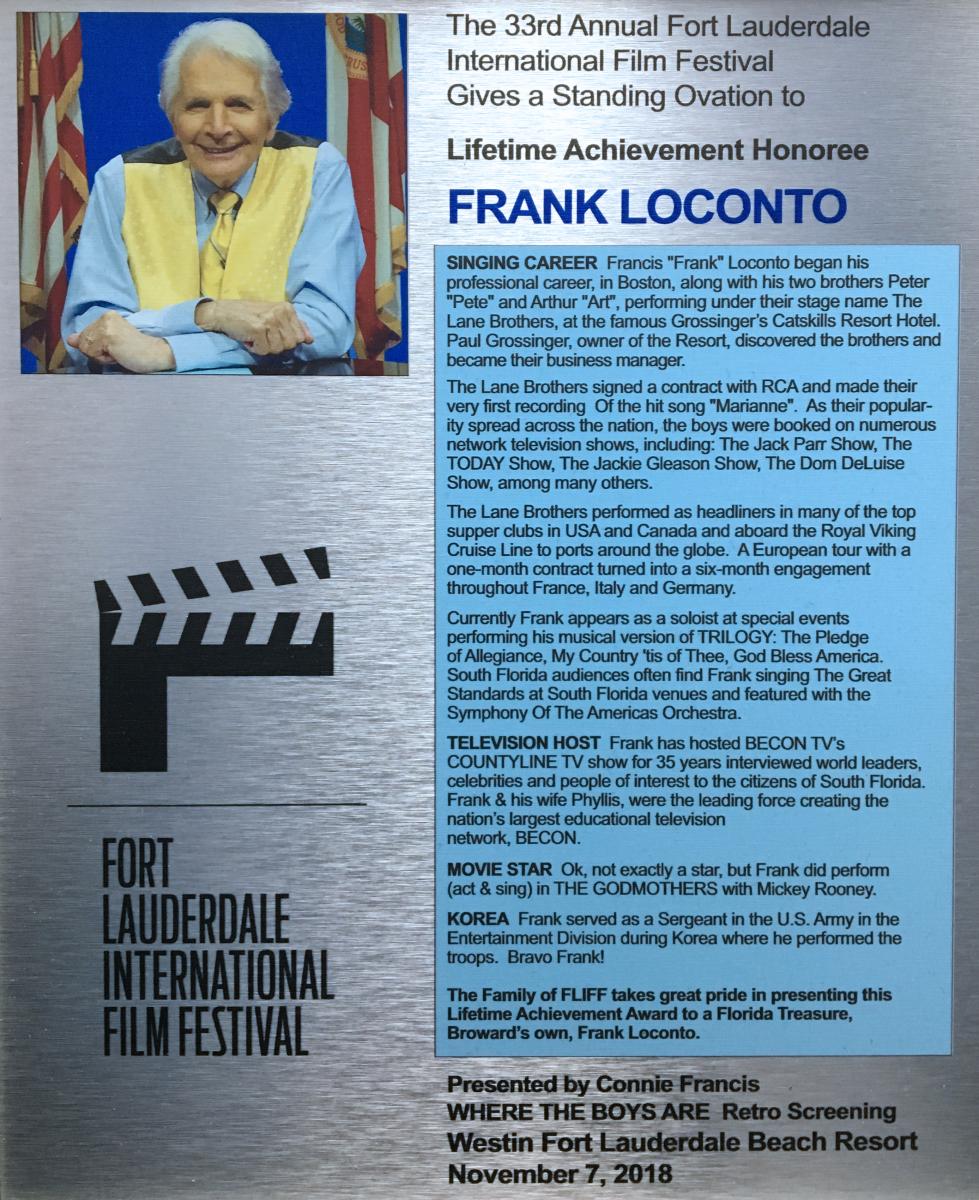
Longtime Fort Lauderdale entertainer and broadcaster Frank Loconto received a well-deserved tribute last fall when he was honored with a lifetime achievement award at the 33rd annual Fort Lauderdale International Film Festival dinner. It was presented by his friend of many years, Connie Francis, a co-star of “Where the Boys Are,” the 1960 film that helped put Fort Lauderdale on the map as a spring break destination. The plaque shown above details his interesting career, beginning with singing with the Lane Brothers in Boston in 1955. He still performs as a soloist at South Florida events.
He launched a second career in broadcasting, and for 35 years has hosted Becon TV’s “Countyline” show, interviewing celebrities and leaders far and wide. Wearing his trademark vests, he calls upon his experiences and contacts of more than 50 years in South Florida, with an interviewing style that is informal, yet always interesting.
For several years Frank sang on Sunday afternoons at Mangos restaurant on Las Olas Boulevard, sometimes joined by former Mangos owner John Day, who also began his career as an entertainer. The restaurant was sold and has been closed for renovations. It is scheduled to reopen very soon as Piazza Italia, a dramatic change of format and cuisine. Frank expects to resume his Sunday afternoon performances under the new ownership.
We made a New Year’s resolution to not waste this valuable space with anything as banal as critiquing sports uniforms. But that was last year’s resolution, which we proudly kept, and this is a brand-new year and some of the 2018 violations of the uniforms code of athletic duds have been so egregious that we must go on record. This is particularly motivated by the results of recent football bowl games, and the coaching shakeups of the last month, all of which relate to some awful uniform decisions by persons who should know better. Please do not think this is an opaque subject. Check the internet. Sports uniforms rank second in internet searches only to President Trump’s sex life.
Let us start with the bowl games. History will show that Notre Dame got blown out by Clemson on Dec. 29, but the truth is they lost that game on Nov. 17—the day they played Syracuse in Yankee Stadium. They won easily that day, 36-3, but in a larger sense, they lost. For that was the day they decided to honor the New York Yankees by wearing the football equivalent of the Yankees’ classic pinstripes. They may make great baseball suits, but they looked awful in football, especially to the 40 million New York Irish fans who turned out with their families to see the Irish in their traditional unadorned gold helmets and pants.
Those fans were crushed, and so was God, who takes Notre Dame football personally. God was already upset a couple of years ago when Notre Dame came out in bilious, green outfits, looking like praying mantises for a game against somebody or other. God was further annoyed earlier this season when ND wore their novelty green jerseys— except the green was not a vibrant Kelly green, but rather an insipid avocado, made even uglier by dark numbers. God vowed to punish them, and it happened against Clemson. There was no Irish luck on replay calls that day. Had they not sinned in New York, they still might not have beaten a very good Clemson team, but at least they would have covered.
Closer to home, the Dolphins fired their coach after several disastrous seasons of wearing teal, a very feminine color, as opposed to aqua green, which might be considered ladylike, except the original Dolphins studs went undefeated with that shade. The current Dolphins made it worse by wearing teal pants with white jerseys and helmets. No symmetry there. Dark pants (think Washington Redskins, Chicago Bears) are only acceptable with dark helmets and white jerseys.
Even worse was the University of Miami where coach Mark Richt, a classy young talent, had no choice but to resign after losing his mind and letting the Hurricanes wear black uniforms in 2017. One of the most visible logos in sports, the orange and green “U” on the team’s white helmets was totally lost against the black helmets. The team never recovered from that diabolical uniform. Back in Howard Schnellenberger's championship days at Miami, the Hurricanes had a great look. When he started a new program at Florida Atlantic, he patterned the uniforms after UM and took the program big time in a hurry. Alas, in recent years FAU has changed its uniforms so many times you don’t even know what the school colors are. They dressed to lose and did.
There are numerous examples of teams with no sense of tradition, but let us replay to the positive. It was no accident that the four teams in the college playoffs all have a strong sense of their identity—at least on the football field. Alabama has almost never broken from its successful look, even with numbers on their helmets instead of a garish logo. Notre Dame, despite the aforementioned crimes, usually looks like it did back in the era of Johnny Lujack in the 1940s. We have not studied Clemson as much, but they seem to stick to a predictably orangy style although we are not fond of solid orange uniforms, or all any color for that matter. Except for white. Oklahoma looks very much like the uncomplicated uniforms it wore when we saw the Sooners play Texas in the Cotton Bowl in 1959.
Speaking of Texas, they are an iconic pacesetter, either in all white, with a minimum of striping, which looks great, or switching to burnt orange jerseys at home. They have always worn horny helmets. That elegant taste was rewarded as they handled Georgia, who also dresses quite well, in the Sugar Bowl. It was a case of good dressing losing to better.
This is being written with the championship game a few days away. Based on history, we must pick Alabama, especially if they wear their crimson home jerseys. On the other hand, if Clemson wears orange jerseys and white britches, we respect their chances. Especially if they score more points.
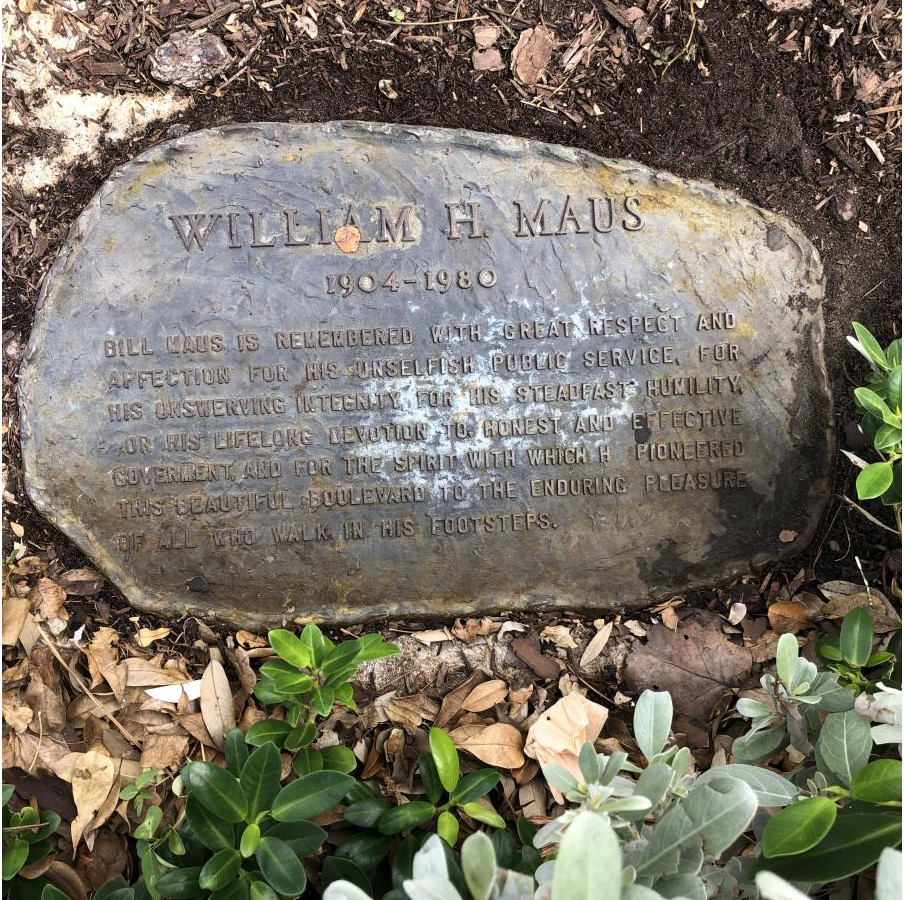
There are very few businesses that can claim to have been in Gold Coast magazine’s first issue 54 years ago. Maus & Hoffman is one of them. In fact, that high-fashion clothing store was on Las Olas Boulevard 25 years before Gold Coast was born. The firm is pushing 80 years in South Florida. William Maus and Frank Hoffman came down from the summer resort town of Petoskey, Michigan, in 1939. After finding locations in Miami too expensive, they opened on Las Olas a year later. Among Las Olas institutions, only the Riverside Hotel (1936) is older.
William Maus became a legendary pioneer on Las Olas. At one time a dozen stores from northern Michigan had followed his company to Las Olas or nearby cities. Las Olas was far less elegant than today’s venue. Among the neighbors was a gas station and auto dealership. Maus was the man who backed the boulevard’s first good restaurant, the recently closed Le Café de Paris. Today Fort Lauderdale’s center of nightlife has numerous fine restaurants, serving the massive influx of new downtown high-rise offices and apartments. Maus & Hoffman expanded around the state years ago. Today, it has locations on Worth Avenue in Palm Beach and stores in Naples and Vero Beach.
William Maus died in 1980, but all five of his children became active in the business. The family jokes that “Maus” means mouse in German; thus “a mouse in every house.” Bill Jr. still works in Fort Lauderdale, as did his late brother Tom. Their brother John, president of the company, runs the Palm Beach store. A sister, Jane Hearne, was in Naples before retiring. Tom Maus Jr. now runs the Las Olas Boulevard store. There is even a fourth generation in the organization. Ted Maus, son of Bill Maus Jr.’s son Arthur, works in the catalog fulfillment division in downtown Fort Lauderdale.
Although it began as a high-end men’s store, it has enlarged its offerings to include women’s clothing. And, as of last month, Maus & Hoffman has a new and appropriate location—in a sense a marriage with the Riverside Hotel. Its old location just a half block away was sold, and the new store has the advantage of an entrance on Las Olas next to the high-traffic Riverside, plus a second entrance in the back from the hotel’s lobby.
It is a union made in history heaven—Las Olas’ two oldest institutions. We wish Maus & Hoffman and the Riverside another 80 years of success.
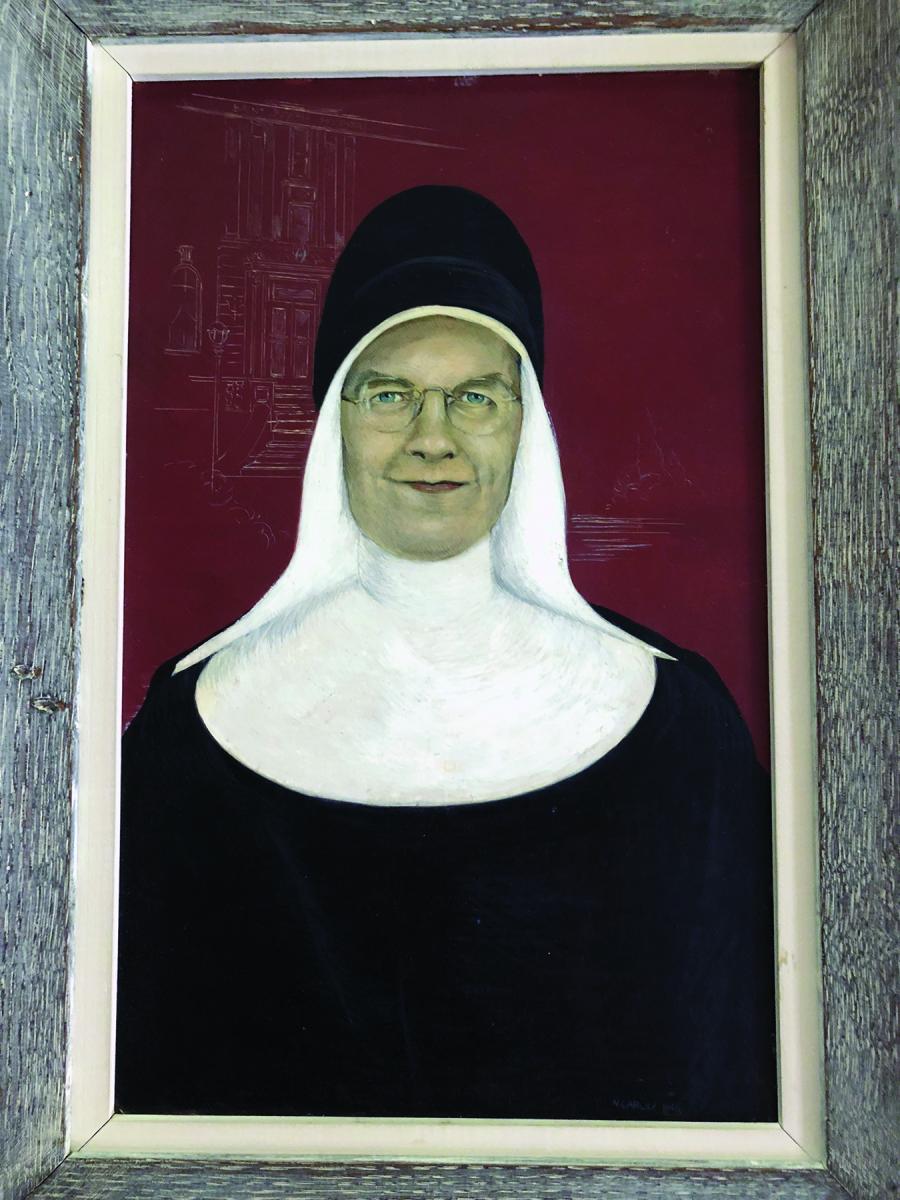
Do you remember what you were doing the last time you turned 100? Nella McNally does. The Fort Lauderdale mother of three, grandmother of six and great-grandmother of nine, is being honored for her artwork both locally and by her Ivy League alma mater.
Ms. McNally’s full name is Ellen Carley McNally, but she goes by Nella, and that nickname goes back a long, long way. She celebrated her 100th birthday in August. The Galt Ocean Mile resident has been painting most of her life and works at it almost every day. That in itself is a story, but a better one is her unique connection to her old school—Yale.
She is a 1945 graduate of Yale’s School of Fine Arts, the oldest of its kind in the country. There she learned a form of painting that had been largely lost for hundreds of years. Egg tempera uses egg yolk as its base and was a common technique in Europe before oil paints were adopted in the 15th century. It was characterized by fast drying and exceptional durability. Just ask Michelangelo. It lost favor over the years, although some prominent artists, including Andrew Wyeth, preserved the medium.
There was a professor at Yale who taught tempera painting to McNally. The teacher is long gone and Yale dropped the course from its curriculum. It had largely forgotten his contribution until McNally’s work was called to its attention. That was done by another Yale alum, retired Fort Lauderdale lawyer Laz Schneider. He is a friend of the artist’s son, Phil McNally, also retired from banking. Not surprisingly, many of Nella McNally’s relatives and acquaintances have added the word “retired” to their resumes. But she is far from retired.
The artist will be part of “Yale 50/150” marking 50 years of Yale University admitting women and 150 years of their granting women art degrees. The event will run from March until November. Yale’s art gallery obviously is a major part of the celebration, and McNally will serve as a link to its past. The school made a two-hour video of McNally’s painting technique. The gallery is also adding one of her works to its permanent collection as an example of the egg tempera technique.
The centenarian artist is not without recognition at home. She was grand prize winner two years ago at the Bonnet House annual juried competition, and recently received a special mention for her more recent work.
The painting chosen for the gallery is a story itself, going back to 1960. McNally was asked by her sister to do a painting of a nun who taught at a now closed small Catholic college in New Hampshire. She was known as Sister Mary Margaret. The relative planned to give the painting to the order to which the nun belonged. The order, however, refused it, terming it “vainglorious.” They must have been humble nuns indeed. Today, no one knows Sister Mary Margaret’s real name. The painting was damaged by water and then restored and was in the home of McNally’s daughter in Connecticut. Now Sister Mary Margaret at last will have a permanent place in one of the world’s great universities. So much for vainglory.

The latest intelligence about accidents involving the fast, new Brightline train between Palm Beach and Miami is that it may be unsafe to sit on the tracks as a train going 79 mph bears down on you.
This astute perception stems from a recent report in The Palm Beach Post of a news conference in which relatives of people killed at crossings claimed that the new high-speed train is unsafe. One of the families was that of a man who police say was actually sitting on the tracks. He was not in a car trying to beat the train, which is the case of some of the other incidents at rail crossings.
Suicide by train is not all that uncommon, unpleasant as it sounds. Even though it has almost no grade crossings, the Northeast Corridor has seen its share of such grisly deaths. Those tracks are fenced in, but victims access the tracks by way of the numerous commuter stations along the route. According to Ali Soule, spokesperson for Brightline, eight of its 10 fatalities over the last year are being investigated as suicides.
The relatives, of course, do not think their kin committed suicide. They call for more safety features to prevent such incidents on a railroad that for years had slow-moving freight trains that encouraged people to take chances at grade crossings, knowing the odds were not that bad. Now, they are. Among the suggestions are more signs, voice warnings, etc. Those ideas, however, collide with the wishes of residents near the tracks who want the loud horns of the train silenced.
While we are a fan of Brightline and consider it long overdue, we concede the families complaining have a point. A train going almost 80 miles an hour at grade level through a busy city with numerous street crossings is inherently dangerous. All it takes is a little absent mindedness to find yourself stopped in heavy traffic on or near the tracks as the gates go down.
Brightline hopes to eliminate the few genuine accidents with simple advice. “We ask people to pay attention,” Soule says. “We ask them to avoid stopping on the tracks or going around gates. You don’t have to beat the train. Just follow the law and don’t take chances.”
Sound advice, but no more likely to be heeded than asking people not to drive 60 miles an hour in a 25 mph zone, or routinely bust red lights, or text while driving. Fatal accidents from such conduct are daily occurrences that make railroad mishaps seem rare.
There is only one real solution to Brightline’s problem: rebuild the railroad. If that sounds ambitious, it is, but it would obviously be a long-term project. There is a fast way to start. Eliminate some grade crossings. This has already happened. There are several streets in downtown Fort Lauderdale that were closed off years ago. A recent one was done to make room for the station just north of Broward Boulevard. The same thing happened in Palm Beach.
Closing off major streets is impractical, although bridging some is feasible where there are no major buildings or businesses that would be seriously affected. But there are dozens or less used crossings in Broward and Palm Beach County, which could be closed without bringing on the end of the world. It might seem that way to some neighbors, who would bring up the usual arguments about delaying emergency vehicles, etc. Those would be countered by homeowners on both sides of the tracks who would find their neighborhoods more private and free from a lot of traffic, eventually enhancing property values.
There are sections of track that run a considerable distance with only a few crossings. One example is from State Road 84 through the Fort Lauderdale-Hollywood International Airport, as far as Griffin Road—a distance of more than two miles. There are similar sections, especially in the less populated areas. If some crossings were eliminated, and the track fenced in, speeds up to 100 mph could be safely attained on those unobstructed stretches. That could permit trains to slow down a bit in congested cities and still maintain fast schedules. It would require an exemption from the 79 mph maximum limit, but that has been done on sections of the Northeast corridor where unobstructed main lines make it safe not just for the high-speed Acela, but also some conventional commuter trains.
Postscript: The train hasn’t even reached there yet, but some of the strongest criticism of Brightline has come from the Treasure Coast. The complaints about safety have reinforced the fact that the train had not planned to stop between West Palm Beach and Orlando. Ali Soule advises that Brightline is addressing that problem, exploring sites for stations in Martin County (Stuart) and Indian River (Vero Beach). That should not only silence some objectors but also greatly add to the usefulness of the service.
Image via
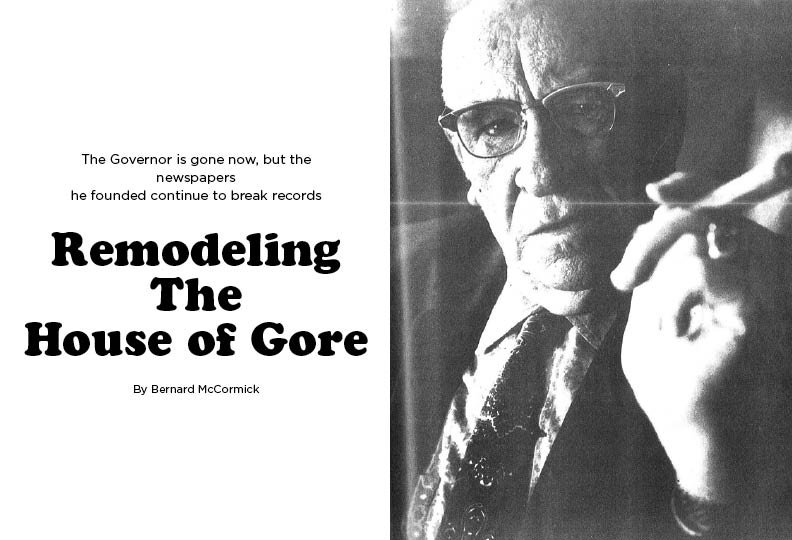
Once upon a journalistic time—the 1970s—South Florida newspapers were among the most successful in the country. The Miami Herald, owned by the Knight Ridder company, had a statewide presence with several bureaus, and had influential readers in most major Florida cities.
In Broward County alone it had a staff of 70 based in an office on Sunrise Boulevard. Its Broward circulation was an impressive 75,000. This was despite the fact that it competed with a very strong Sun-Sentinel, which at the time was one of two dailies in the same organization. The Fort Lauderdale News was the larger evening paper; the Sun-Sentinel was morning. There was also the Sun-Tattler in Hollywood, which had a respectable 50,000 circulation. The Herald also had competition in Miami from the small but feisty Miami News (ceased in 1988), which had some of the top talent in the area, and (until 1971) the Miami Beach Sun.
In terms of its Latin American coverage The Herald enjoyed the kind of respect the Washington Post does today in the nation’s capital. Knight Ridder owned 31 other papers, including The Philadelphia Inquirer, which it turned from a disgraced paper under former owner Walter Annenberg into one of the best in the country. Although largely forgotten today, the company also published the small The News in Boca Raton, which it used as a training ground for its promising young reporters and editors.
R.H. Gore, a tough and highly competitive businessman who sold his company to the Chicago Tribune, had owned the Fort Lauderdale News and the Sun-Sentinel for years. The News was one of the most profitable evening papers. Gold Coast magazine detailed its clout:
“Figures for the first eight months of 1973 show the Fort Lauderdale News running first in total advertising lineage among all the evening papers in the country.” The only papers with more advertising were all morning sheets.
It later became a morning paper and the name Sun-Sentinel was adopted when the two papers merged in 1982. Serving a fast-growing market of Broward and south Palm Beach County, its Sunday circulation reached more than 300,000.
The Sun-Sentinel did not have the journalistic clout of The Herald, but it did a good job on the bread and butter news, such as local politics and high school sports coverage.
The Palm Beach Post was also a very successful product, although its growth was stunted by competition from the Sun-Sentinel, which moved aggressively to dominate the southern half of Palm Beach County, and papers on the Treasure Coast, which limited its growth to the north.
Those glory days are long gone. As Dan Christensen recently reported on his Florida Bulldog blog, all three papers continue to lose circulation. Although located in high growth markets, the papers are losing readers faster than the national average. Virtually all newspapers are suffering. The pain began in the 1990s and has gotten worse year by year, as the internet and expanded television news have made print publications relevant to far fewer people, and have virtually destroyed the profitable classified advertising sections.
The numbers are grim: Christensen reported the Herald’s daily circulation has dropped in the last decade from 164,000 to 53,000, although its Spanish language Nuevo Herald adds another 25,000. The Palm Beach Post just a few years ago reported a daily circulation of over 100,000; it is now around 53,000. The Sun-Sentinel is down from 100,000 to around 75,000.
Like papers all over the country, South Florida’s dailies have gone digital, which although increasing readership, provides nothing like the print editions’ income.
Shortly after Florida Bulldog’s report, Buddy Nevins, commenting on Christensen’s work, reported on his popular Broward Beat blog that the Herald and Sun-Sentinel were considering a merger, which would likely result in staff reductions (which have already been drastic) as well as lack of competition.
Christensen and Nevins, by the way, are friends. They both have strong newspaper backgrounds—Nevins at the Sun-Sentinel and Christensen at The Herald. Their work helps fill the void left by the newspaper's demise. Nevins continues the political commentary, which distinguished him at the Sun-Sentinel. Christensen’s investigative reports command a loyal audience, which has grown beyond South Florida. Notable has been his dogged pursuit of an apparent cover up of the 9/11 attacks—the possible involvement of members of the Saudi Arabian royal family who were living in Sarasota. They had been in touch with several of the hijackers, and left the country in a hurry, leaving cars and household furnishings behind, just before the attack. This suspicious information was never given to former Sen. Bob Graham, who headed the 9/11 investigating commission. He has worked closely with Christensen in the effort to pierce the secrecy surrounding that tragic morning.
Back on topic, Buddy Nevins’ rumors are usually pretty reliable, and if the two major papers do merge, the Miami Dade-Broward market, which in the early 1970s had six daily newspapers, will be down to only one. No wonder the term “low information” is being applied to so many of our paperless citizens.
